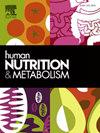Analysis of dietary amino acid and fatty acid intake profiles of US adults: NHANES 2017–March 2020 Pre-pandemic
IF 1.8
Q3 ENDOCRINOLOGY & METABOLISM
引用次数: 0
Abstract
Recently, the digitalization of data science in nutrition has highlighted the need for comprehensive dietary databases to interpret dietary habits accurately. Previous studies have elucidated detailed profiles of amino acids (AAs) and fatty acids (FAs) in the Japanese diet beyond the general categories of proteins and lipids. This study aimed to profile the intake of AAs and FAs in the United States (U.S.) population, focusing on the quantity of these nutrients. By linking the USDA National Nutrient Database for Standard Reference with the National Health and Nutrition Examination Survey 2017–March 2020 data, we estimated the average dietary intake of 18 AAs and 19 FAs in the U.S. population, expressed in mg/1000 kcal and calculated their respective contributions. Among the 18 AAs, glutamic acid, aspartic acid, and leucine were the most consumed, accounting for 19.8 %, 9.1 %, and 8.1 % of the total intake, respectively. Among the 19 FAs, 18:1 constituted the most significant proportion at 36.5 %, followed by 18:2 at 23.3 % and 16:0 at 20.1 %. Although the intake contribution profiles of AA were similar across different food groups, those of FA varied significantly. Overall, we successfully developed a database showing the average intake of AA and FA in the U.S. population rather than focusing solely on proteins and lipids. This database provides a foundation for accurately understanding and interpreting dietary habits in the U.S. population and suggests its potential use as a reference for future international dietary comparisons.

美国成年人膳食氨基酸和脂肪酸摄入量分析:NHANES 2017-March 2020
最近,营养数据科学的数字化凸显了对全面的饮食数据库的需求,以准确地解释饮食习惯。以前的研究已经阐明了日本饮食中蛋白质和脂类之外的氨基酸(aa)和脂肪酸(FAs)的详细概况。本研究旨在分析美国人群中aa和FAs的摄入量,重点关注这些营养素的数量。通过将美国农业部国家营养标准参考数据库与2017年3月至2020年3月的国家健康与营养检查调查数据联系起来,我们估计了美国人群中18种aa和19种FAs的平均膳食摄入量,以mg/1000 kcal表示,并计算了它们各自的贡献。在18种氨基酸中,谷氨酸、天冬氨酸和亮氨酸的摄入量最多,分别占总摄入量的19.8%、9.1%和8.1%。在19个FAs中,18:1的比例最大,为36.5%,其次是18:2(23.3%)和16:0(20.1%)。虽然不同食物组AA的摄入贡献谱相似,但FA的摄入贡献谱差异显著。总的来说,我们成功地开发了一个数据库,显示了美国人口中AA和FA的平均摄入量,而不仅仅是蛋白质和脂质。该数据库为准确理解和解释美国人口的饮食习惯提供了基础,并建议将其作为未来国际饮食比较的参考。
本文章由计算机程序翻译,如有差异,请以英文原文为准。
求助全文
约1分钟内获得全文
求助全文
来源期刊

Human Nutrition and Metabolism
Agricultural and Biological Sciences-Food Science
CiteScore
1.50
自引率
0.00%
发文量
30
审稿时长
188 days
 求助内容:
求助内容: 应助结果提醒方式:
应助结果提醒方式:


